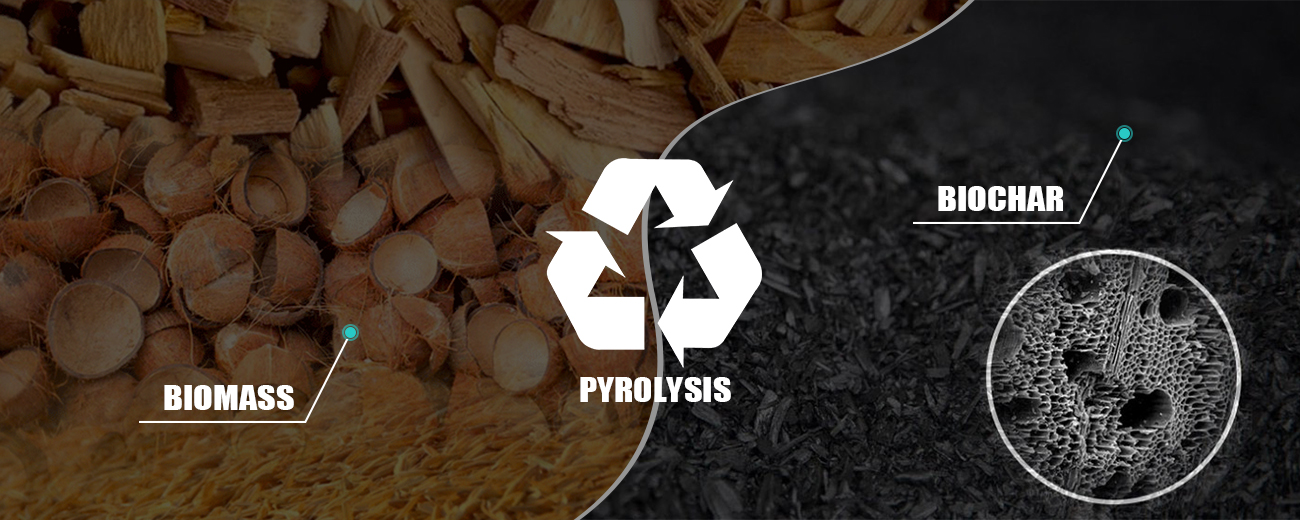As the global community grapples with climate change, soil degradation, and the need for sustainable waste management, biomass pyrolysis has emerged as a promising solution. By thermochemically converting organic waste into value-added products, pyrolysis offers a circular, low-carbon pathway to manage biomass residues. Among its outputs, biochar stands out for its potential in carbon sequestration, soil improvement, and pollution control.
What is Biomass Pyrolysis?
Biomass pyrolysis is a thermal decomposition process that occurs in the absence of oxygen. Unlike combustion, which burns biomass to produce energy, pyrolysis breaks down organic matter at temperatures between 300°C and 700°C, yielding three main products:
- Biochar: A carbon-rich, solid residue.
- Bio-oil: A dark, viscous liquid with energy potential.
- Syngas: A mixture of combustible gases like CO, H2, and CH4.
The proportions of these products depend on several factors, including the type of biomass, heating rate, and residence time. Pyrolysis can be classified into slow, fast, and flash pyrolysis, each optimized for different outputs.

Biochar: The Key Product
Biochar is more than just charcoal. Produced under controlled pyrolysis conditions, it retains the structural complexity of the original biomass while gaining new physicochemical properties. This makes it uniquely suited for agricultural and environmental applications.
In agriculture, biochar improves soil fertility, enhances water retention, and promotes microbial activity. When applied to soils, it also stabilizes carbon for hundreds to thousands of years, effectively acting as a carbon sink.
Biochar Characterization: Why It Matters
Not all biochars are created equal. Their properties vary widely depending on feedstock (e.g., wood, crop residue, manure) and pyrolysis conditions. So choosing reliable biomass pyrolysis plant is important. Characterization is essential to determine the suitability of a particular biochar for specific applications. Common parameters and techniques include:
- Proximate and Ultimate Analysis: Determines moisture content, ash, volatile matter, and fixed carbon, as well as elemental composition (C, H, N, O, S).
- Surface Area and Porosity: Measured using BET (Brunauer–Emmett–Teller) analysis, important for adsorption and nutrient retention.
- pH and Electrical Conductivity: Affect biochar’s influence on soil acidity and nutrient availability.
- Fourier Transform Infrared Spectroscopy (FTIR): Identifies functional groups responsible for interactions with soil and contaminants.
- Scanning Electron Microscopy (SEM): Provides detailed images of the biochar surface and pore structure.
Applications of Biochar
Biochar’s versatility has led to a growing number of applications across different sectors:
- Agriculture: Enhances soil structure, nutrient retention, and crop yield.
- Wastewater Treatment: Adsorbs heavy metals, dyes, and organic pollutants.
- Climate Change Mitigation: Stores carbon long-term, reducing greenhouse gas emissions.
- Livestock Farming: Used as feed additive or bedding to reduce methane emissions and odors.
- Construction: Incorporated into concrete and asphalt to reduce material emissions.
Challenges and Future Prospects
While the promise of biochar is substantial, several challenges remain. Standardizing biochar production and classification, ensuring economic viability, and gaining regulatory approval for various uses are key hurdles. Additionally, large-scale adoption will require strong policy support, public awareness, and integrated research efforts.
Future innovations may include engineered biochars with customized properties, such as nano-biochar for advanced environmental applications or nutrient-enriched biochars for precision farming.
Conclusion
Biomass pyrolysis and biochar production offer a sustainable, multi-benefit solution to some of the world’s most pressing environmental challenges. By turning waste into a high-value resource, this technology supports a greener, more resilient future. As research deepens and technologies mature, biochar may soon become a staple of climate-smart agriculture and circular economy practices.
Leave a Reply